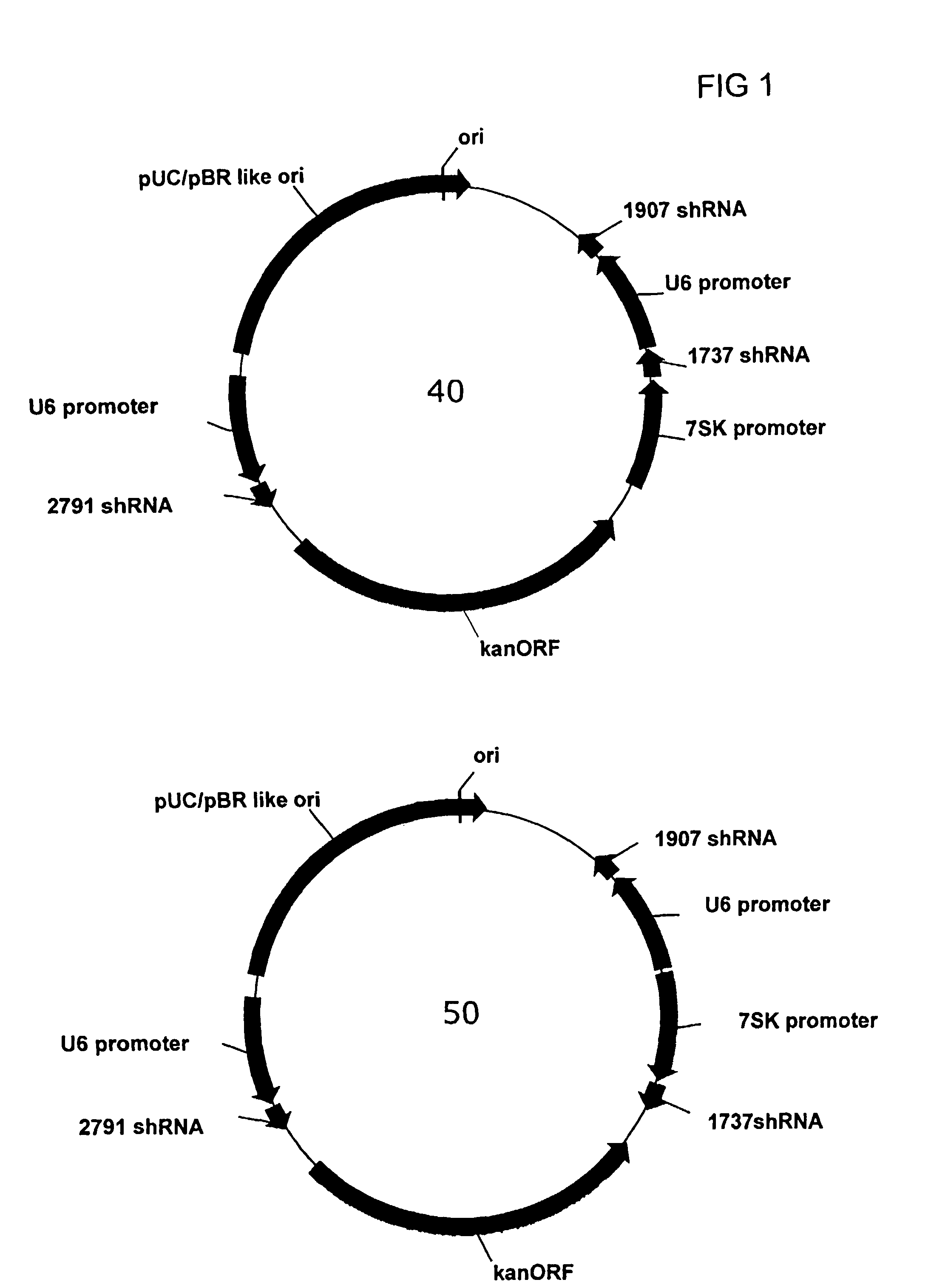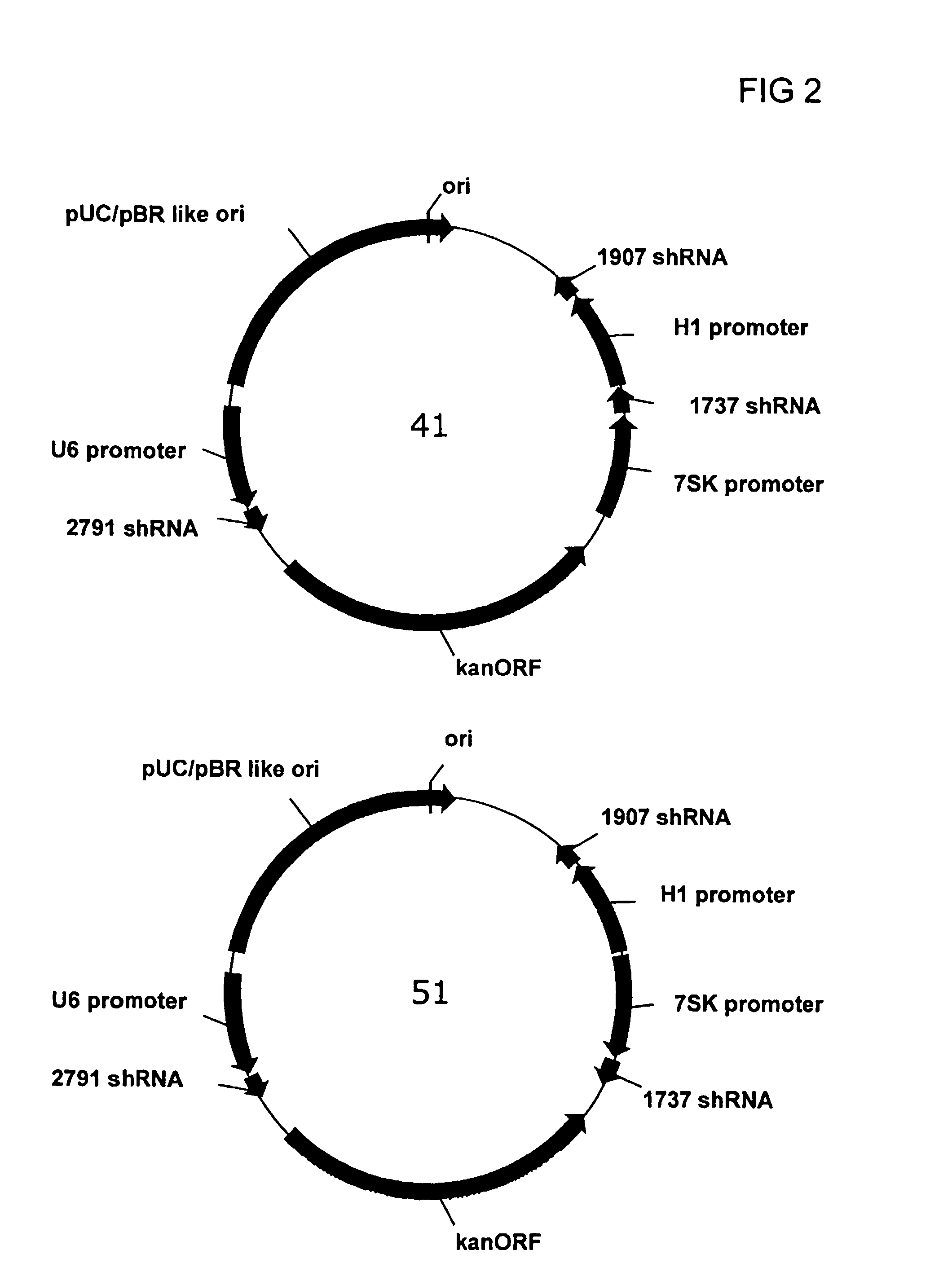Multiple RNA polymerase III promoter expression constructs
a polymerase and promoter technology, applied in the field of new rna polymerase iii promoter expression constructs, can solve the problems of unsatisfactory non-specific cytotoxicity or cell death, difficult transfection of cells, and unoptimized production of small rnas
- Summary
- Abstract
- Description
- Claims
- Application Information
AI Technical Summary
Benefits of technology
Problems solved by technology
Method used
Image
Examples
example 1
A Tricistronic RNA Polymerase III-Based Expression Construct for Production of shRNAs which Reduce Hepatitis B RNA Production and Replication
[0119]A series of plasmids were constructed to express three different Hepatitis B targeting shRNAs under the independent control of 3 separate RNA polymerase III promoters. The U6 and 7SK promoter / shRNA cassettes were placed adjacent to each other in the multiple cloning site of the vector, while a distal cloning site (adjacent to the kanamycin resistance gene) was used for the third promoter sequence (either the second copy of the U6 promoter or the H1 promoter). The 5′ end of each shRNA element was joined to the 3′ end of each promoter using a convenient restriction site, e.g., Sal I or HindIII, engineered by introducing 6 nt between the 3′ end of the promoter and the start of the shRNA sequence. The sequence for each of the promoter elements is given in FIG. 4. The three shRNA sequences placed in the tricistronic vector, identified as 2791,...
example 2
A Four-Promoter RNA Polymerase III-Based Expression Construct for Production of shRNAs which Reduce Hepatitis B RNA Production and Replication
[0125]FIG. 9 is a diagram of vector pHB4 which contains 4 polymerase III promoter-shRNA cassettes. The labeling of the figure indicates the promoter name, the associated shRNA (targeting the HBV genome) and the direction of transcription for each cassette. The vector was constructed as described above using an iterative process of adding shRNA cassettes stepwise. The data in FIG. 10 (a luciferase assay essentially similar to that used in Example 1) indicate that all 4 promoter / shRNA cassettes were active in silencing their target sequences in a cell supplied with the vector and an assayable substrate (luciferase fusion constructs as in Example 1, now including the shRNA-799 construct). The Table in FIG. 10 shows triplicate independent experiments for pHB4 and as positive controls, results from the single hairpin vectors are given as well. The ...
example 3
A Multiple RNA Polymerase III Promoter Vector in which a Single Promoter Expresses a 2-Hairpin (Bi-Finger) Containing Short RNA
[0126]In another embodiment of this invention comprising multiple Pol III promoter vectors, it is possible to express more than one shRNA effector molecule from a single promoter, thus increasing the number of RNA sequences it is possible to target with a greater economy of promoter elements. For example, the invention can be used to express 3 shRNA molecules using only 2 Pol III promoters; 4, 5, or 6 shRNA molecules using only 3 pol III promoters; 5, 6, 7, or 8 shRNA molecules using 4 pol III promoters, etc. The expression of a “double-hairpin” or bi-fingered dsRNA was demonstrated here by creating a U6 promoter vector in which two of the HBV targeting shRNA-encoding sequences (FIG. 5) were connected by short spacer elements to produce one longer RNA molecule (total lengths of approximately 140 nucleotides using the long spacer, approximately 60 bases using...
PUM
| Property | Measurement | Unit |
|---|---|---|
| OD | aaaaa | aaaaa |
| OD | aaaaa | aaaaa |
| OD | aaaaa | aaaaa |
Abstract
Description
Claims
Application Information
 Login to View More
Login to View More - R&D
- Intellectual Property
- Life Sciences
- Materials
- Tech Scout
- Unparalleled Data Quality
- Higher Quality Content
- 60% Fewer Hallucinations
Browse by: Latest US Patents, China's latest patents, Technical Efficacy Thesaurus, Application Domain, Technology Topic, Popular Technical Reports.
© 2025 PatSnap. All rights reserved.Legal|Privacy policy|Modern Slavery Act Transparency Statement|Sitemap|About US| Contact US: help@patsnap.com



